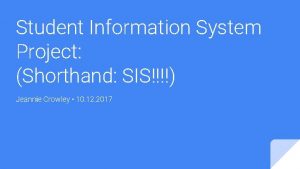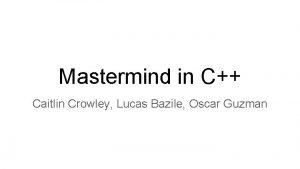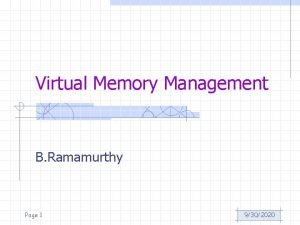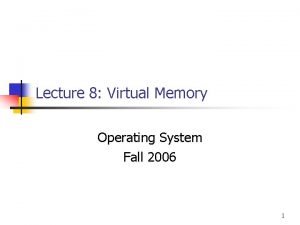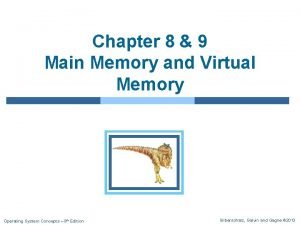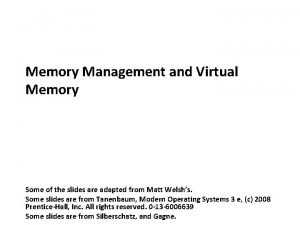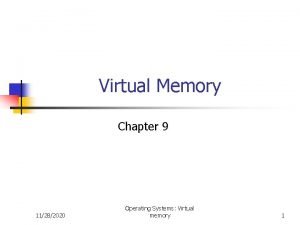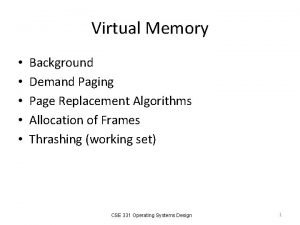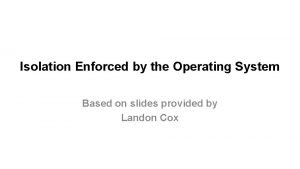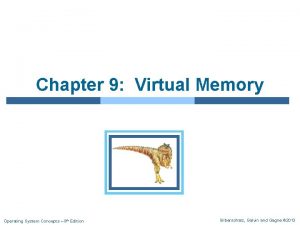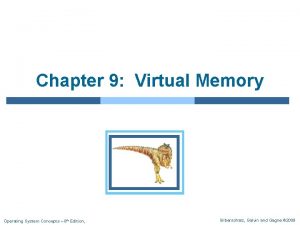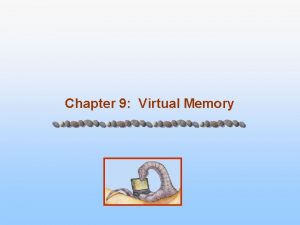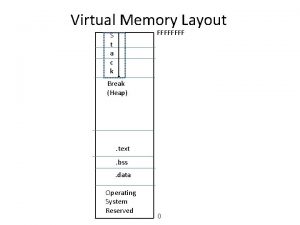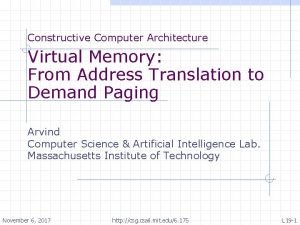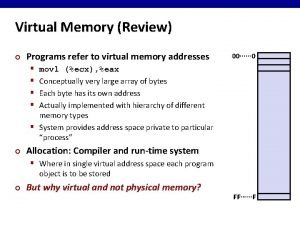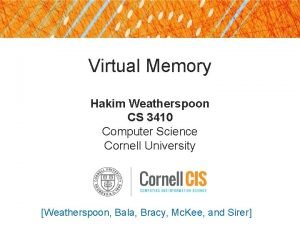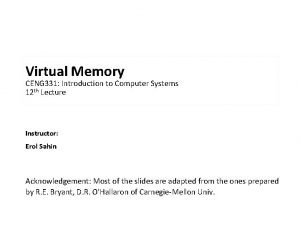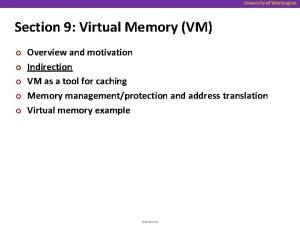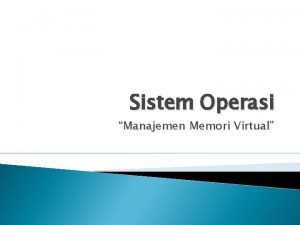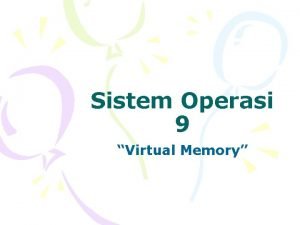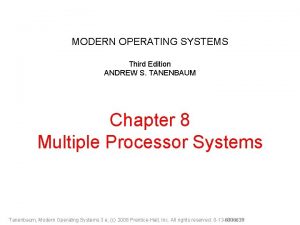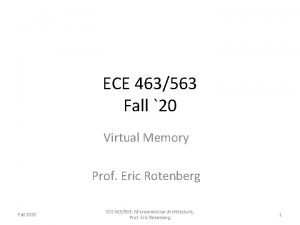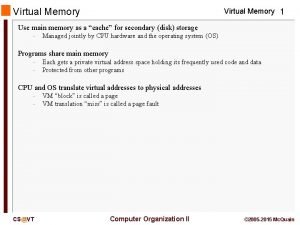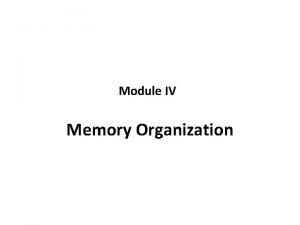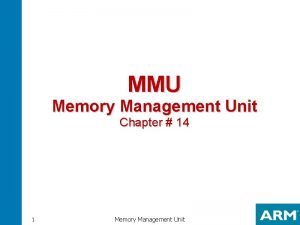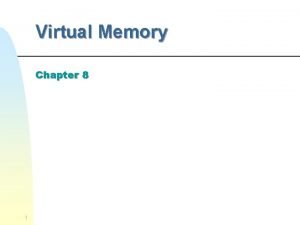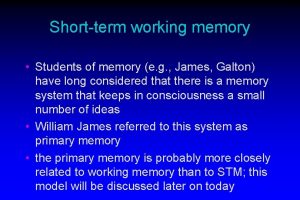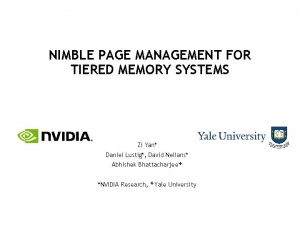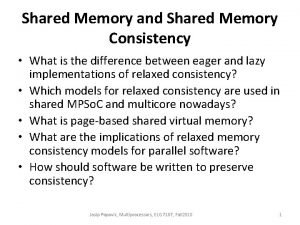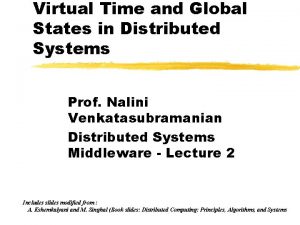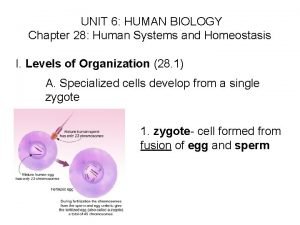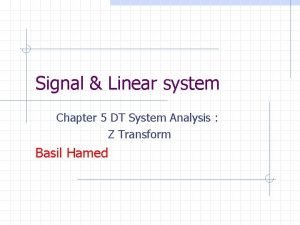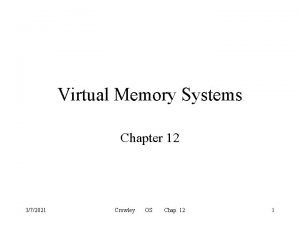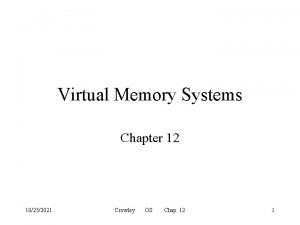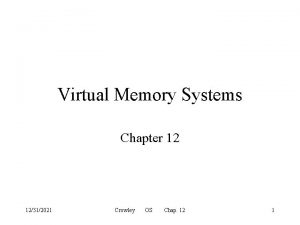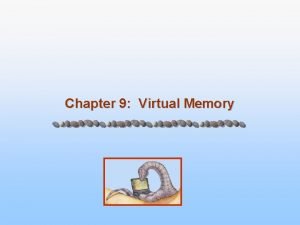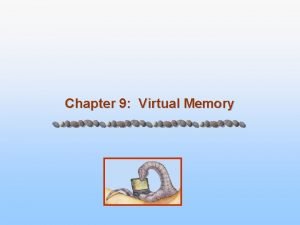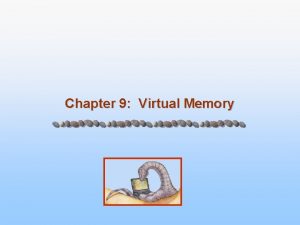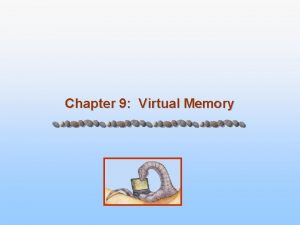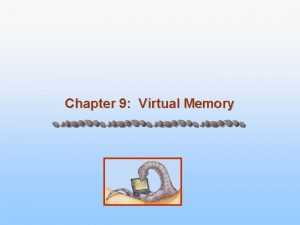Virtual Memory Systems Chapter 12 11282020 Crowley OS











































































- Slides: 75

Virtual Memory Systems Chapter 12 11/28/2020 Crowley OS Chap. 12 1

Key concepts in chapter 12 • Page replacement algorithms – global – local • Working set • Load control • Large page tables – two and three level paging – inverted page tables • Segmentation 11/28/2020 Crowley OS Chap. 12 2

Page replacement • Placement is simple in paging systems (just put a page in a page frame) – but hard in segmentation systems • The problem is replacement – which page to remove from memory to make room for a new page • We need a page replacement algorithm • Two categories of replacement algorithms – local algorithms always replace a page from the process that is bringing in a new page – global algorithm can replace any page 11/28/2020 Crowley OS Chap. 12 3

Page references • Processes continually reference memory – and so generate a sequence of page references • The page reference sequence tells us everything about how a process uses memory • We use page reference sequences to evaluate paging algorithms – we see how many page faults the algorithm generates on a particular page reference sequence with a given amount of memory 11/28/2020 Crowley OS Chap. 12 4

Evaluating page replacement algorithms • The goal of a page replacement algorithm is to produce the fewest page faults • We can compare two algorithms – on a range of page reference sequences • Or we can compare an algorithm to the best possible algorithm • We will start by considering global page replacement algorithms 11/28/2020 Crowley OS Chap. 12 5

Optimal replacement algorithm • The one that produces the fewest possible page faults on all page reference sequences • Algorithm: replace the page that will not be used for the longest time in the future • Problem: it requires knowledge of the future • Not realizable in practice – but it is used to measure the effectiveness of realizable algorithms 11/28/2020 Crowley OS Chap. 12 6

Theories of program behavior • All replacement algorithms try to predict the future and act like the optimal algorithm • All replacement algorithms have a theory of how program behave – they use it to predict the future, that is, when pages will be referenced – then the replace the page that they think won’t be referenced for the longest time. 11/28/2020 Crowley OS Chap. 12 7

Random page replacement • • Algorithm: replace a random page Theory: we cannot predict the future at all Implementation: easy Performance: poor – but it is easy to implement – but the best case, worse case and average case are all the same 11/28/2020 Crowley OS Chap. 12 8

Random page replacement 11/28/2020 Crowley OS Chap. 12 9

FIFO page replacement • Algorithm: replace the oldest page • Theory: pages are use for a while and then stop being used • Implementation: easy • Performance: poor – because old pages are often accessed, that is, theory if FIFO is not correct 11/28/2020 Crowley OS Chap. 12 10

FIFO page replacement 11/28/2020 Crowley OS Chap. 12 11

LRU page replacement • Least-recently used (LRU) • Algorithm: remove the page that hasn’t been referenced for the longest time • Theory: the future will be like the past, page accesses tend to be clustered in time • Implementation: hard, requires hardware assistance (and then still not easy) • Performance: very good, within 30%-40% of optimal 11/28/2020 Crowley OS Chap. 12 12

LRU model of the future 11/28/2020 Crowley OS Chap. 12 13

LRU page replacement 11/28/2020 Crowley OS Chap. 12 14

Approximating LRU • LRU is difficult to implement – usually it is approximated in software with some hardware assistance • We need a referenced bit in the page table entry – turned on when the page is accessed – can be turned off by the OS (with a privileged instruction) • there are instructions to read and write the accessed bit (and often to turn off all the accessed bits) 11/28/2020 Crowley OS Chap. 12 15

First LRU approximation • When you get a page fault – replace any page whose referenced bit is off – then turn off all the referenced bits • Two classes of pages – Pages referenced since the last page fault – Pages not referenced since the last page fault • the least recently used page is in this class but you don’t know which one it is • A crude approximation of LRU 11/28/2020 Crowley OS Chap. 12 16

Second LRU approximation • Algorithm: – Keep a counter for each page – Have a daemon wake up every 500 ms and • add one to the counter of each page that has not been referenced • zero the counter of pages that have been referenced • turn off all referenced bits – When you get a page fault • replace the page whose counter is largest • Divides pages into 256 classes 11/28/2020 Crowley OS Chap. 12 17

LRU and its approximations 11/28/2020 Crowley OS Chap. 12 18

A clock algorithm 11/28/2020 Crowley OS Chap. 12 19

Clock algorithms • Clock algorithms try to approximate LRU but without extensive hardware and software support • The page frames are (conceptually) arranged in a big circle (the clock face) • A pointer moves from page frame to page frame trying to find a page to replace and manipulating the referenced bits • We will look at three variations • FIFO is actually the simplest clock algorithm 11/28/2020 Crowley OS Chap. 12 20

Basic clock algorithm • When you need to replace a page – look at the page frame at the clock hand – if the referenced bit = 0 then replace the page – else set the referenced bit to 0 and move the clock hand to the next page • Pages get one clock hand revolution to get referenced 11/28/2020 Crowley OS Chap. 12 21

Modified bit • Most paging hardware also has a modified bit in the page table entry – which is set when the page is written to • This is also called the “dirty bit” – pages that have been changed are referred to as “dirty” – these pages must be written out to disk because the disk version is out of date • this is called “cleaning” the page 11/28/2020 Crowley OS Chap. 12 22

Second chance algorithm • When you need to replace a page – look at the page frame at the clock hand – if (referenced. Bit=0 && modified. Bit=0) then replace the page – else if(referenced. Bit=0 && modified. Bit=1) then set modified. Bit to 0 and move on – else set referenced. Bit to 0 and move on • Dirty pages get a second chance because they are more expensive to replace 11/28/2020 Crowley OS Chap. 12 23

Clock algorithm flow chart 11/28/2020 Crowley OS Chap. 12 24

Working set • A page in memory is said to be resident • The working set of a process is the set of pages it needs to be resident in order to have an acceptable low paging rate. • Operationally: – Each page reference is a unit of time – The page reference sequence is: r 1, r 2, …, r. T where T is the current time – W(T, θ) = {p | p = rt where T-θ < t < T } is the working set 11/28/2020 Crowley OS Chap. 12 25

Program phases • Processes tend to have stable working sets for a period of time called a phase • Then they change phases to a different working set • Between phases the working set is unstable – and we get lots of page faults 11/28/2020 Crowley OS Chap. 12 26

Working set phases 11/28/2020 Crowley OS Chap. 12 27

Working set algorithm • Algorithm: – Keep track of the working set of each running process – Only run a process if its entire working set fits in memory • Too hard to implement so this algorithm is only approximated 11/28/2020 Crowley OS Chap. 12 28

WSClock algorithm • A clock algorithm that approximates the working set algorithm • Efficient • A good approximation of working set 11/28/2020 Crowley OS Chap. 12 29

Design technique: Working sets • The working set idea comes up in many areas, it tells you how bit your cache needs to be to work effectively • A user may need two or more windows for a task (e. g. comparing two documents) – unless both windows are visible the task may be much harder to do • Multiple-desktop window managers are based on the idea of a working set of windows for a specific task 11/28/2020 Crowley OS Chap. 12 30

Evaluating paging algorithms • Mathematical modeling – powerful where it works – but most real algorithms cannot be analyzed • Measurement – implement it on a real system and measure it – extremely expensive • Simulation – reasonably efficient – effective 11/28/2020 Crowley OS Chap. 12 31

Simulation of paging algorithms 11/28/2020 Crowley OS Chap. 12 32

Performance of paging algorithms 11/28/2020 Crowley OS Chap. 12 33

Thrashing • VM allows more processes in memory, so one is more likely to be ready to run • If CPU usage is low, it is logical to bring more processes into memory • But, low CPU use may to due to too many pages faults because there are too many processes competing for memory • Bringing in processes makes it worse, and leads to thrashing 11/28/2020 Crowley OS Chap. 12 34

Load control • Load control: deciding how many processes should be competing for page frames – too many leads to thrashing – too few means that memory is underused • Load control determines which processes are running at a point in time – the others have no page frames and cannot run • CPU load is a bad load control measure • Page fault rate is a good load control measure 11/28/2020 Crowley OS Chap. 12 35

Load control and page replacement 11/28/2020 Crowley OS Chap. 12 36

Swapping • Swapping originally meant to write one process out to disk and read another process into memory – swapping was used in early time-sharing systems • Now “swapping” a process out means to not schedule it and let the page replacement algorithm (slowly) take all its page frames – it is not all written out at once 11/28/2020 Crowley OS Chap. 12 37

Two levels of scheduling 11/28/2020 Crowley OS Chap. 12 38

Load control algorithms • A load control algorithm measures memory load and swaps processes in and out depending on the current load • Load control measures – rotational speed of the clock hand – average time spent in the standby list – page fault rate 11/28/2020 Crowley OS Chap. 12 39

Page fault frequency load control • L = mean time between page faults • S = mean time to service a page fault • Try to keep L = S – if L < S, then swap a process out – if L > S, then swap a process in • If L = S, then the paging system can just keep up with the page faults 11/28/2020 Crowley OS Chap. 12 40

Predictive load control • Page fault frequency reacts after the page fault rate is already too high or too low – it is a form of reactive load control • It would be better to predict when the page fault rate is going to be too high and prevent it from happening – for example we know that a newly loading processes will cause a lot of page faults – so, only allow one loading process at a time (this is called the LT/RT algorithm) 11/28/2020 Crowley OS Chap. 12 41

Demand paging • So far we have seen demand paging: bring a page in when it is requested • We could do predictive paging, known as prepaging – but how do we know when a page will be needed in the near future? – Generally we don’t and that is why prepaging is not commonly done. 11/28/2020 Crowley OS Chap. 12 42

Large address spaces • Large address spaces need large page tables • Large page tables take a lot of memory – 32 bit addresses, 4 K pages => 1 M pages – 1 M pages => 4 Mbytes of page tables • But most of these page tables are rarely used because of locality 11/28/2020 Crowley OS Chap. 12 43

Two-level paging • Solution: reuse a good idea – We paged programs because their memory use of highly localized – So let’s page the page tables • Two-level paging: a tree of page tables – Master page table is always in memory – Secondary page tables can be on disk 11/28/2020 Crowley OS Chap. 12 44

Two-level paging 11/28/2020 Crowley OS Chap. 12 45

Another view of two-level paging 11/28/2020 Crowley OS Chap. 12 46

Two-level paging • Benefits – page table need not be in contiguous memory – allow page faults on secondary page tables • take advantage of locality – can easily have “holes” in the address space • this allows better protection from overflows of arrays, etc • Problems – two memory accesses to get to a PTE – not enough for really large address spaces • three-level paging can help here 11/28/2020 Crowley OS Chap. 12 47

Three-level paging 11/28/2020 Crowley OS Chap. 12 48

Software page table lookups • If TLB misses are uncommon, we can afford to handle them in software – and it can structure the page tables any way it wants • Time to handle various paging events Event 1 -level 2 -level 3 -level software TLB hit 1 1 TLB miss 2 3 4 10 -50 Page fault 100 K 11/28/2020 Crowley OS Chap. 12 49

Inverted page tables • An common data structure for softwaremanaged page tables • Keep a table of pages frames not pages – Problem: we want to look up pages by page number, not page frame number – Solution: use clever data structures (e. g. a hash table) 11/28/2020 Crowley OS Chap. 12 50

Software page table lookup 11/28/2020 Crowley OS Chap. 12 51

Normal page tables 11/28/2020 Crowley OS Chap. 12 52

Inverted page tables 11/28/2020 Crowley OS Chap. 12 53

Design technique: Changing with technology • Early on people tried software paging – but it was way too slow – so they tried using hardware register • They they changed to page table in memory – and TLBs to make it fast enough – but TLBs with high hit rates meant that software paging became efficient – so we let the OS handle the paging after a TLB miss 11/28/2020 Crowley OS Chap. 12 54

Recursive address spaces • Another way to “use a good idea twice” • The OS runs in the system virtual address space • The user page tables are in the system virtual address space 11/28/2020 Crowley OS Chap. 12 55

Two levels of virtual memory 11/28/2020 Crowley OS Chap. 12 56

Two ways to do two-level paging 11/28/2020 Crowley OS Chap. 12 57

Page the OS? • Yes, we can page OS code and data too – but some code must always be in memory – like the paging code and the dispatching code • Locking pages in memory – prevent them from being paged out – for vital part of the OS – for pages involved in an I/O operation 11/28/2020 Crowley OS Chap. 12 58

Page size factors • Large pages – load nearly as fast as small pages – load with fewer page faults – mean smaller page tables • Small pages – have less internal fragmentation – bring less useful code and data into memory • Page clustering – loads several pages together (in a cluster) – allows fast loading even with small pages 11/28/2020 Crowley OS Chap. 12 59

Segmentation • A segment is a variable-sized section of memory that is used for one purpose – one procedure, one array, one structure, etc. • Segmentation moves code/data between disk and memory in variable-sized segments not fixed-size pages – otherwise it is just like paging • The address space is two-dimensional <segment, offset> 11/28/2020 Crowley OS Chap. 12 60

Segmentation 11/28/2020 Crowley OS Chap. 12 61

History of segmentation • Segmentation has been tried on several machine, most notably Burroughs machines – but it was never too successful, the advantage of fixed size units was too great • Segmentation only existed now in the form of large segments that are themselves paged – a variation on two-level paging 11/28/2020 Crowley OS Chap. 12 62

Design technique: use fixed-size objects • Paging wins because dynamic storage allocation is too slow – pages have fixed size and placement is trivial • Fixed-sized objects are much easier to manage, no searching, they are all the same • Often we can convert variable sized objects to a sequence of fixed size objects – For example, keep variable-length strings in a linked list of blocks with 32 characters each 11/28/2020 Crowley OS Chap. 12 63

Sharing memory • Processes have separate address spaces – but sometime they want to share memory • it is a fast way to communicate between processes, it is a form of IPC • it is a way to share common data or code • We can map the same page into two address spaces (that is, map it in two page tables) – but they might have different addresses in the two address spaces 11/28/2020 Crowley OS Chap. 12 64

Two processes sharing code 11/28/2020 Crowley OS Chap. 12 65

Swap area variations • Usually the swap area is a dedicated disk partition • It can also be a regular file in the file system – but this is less efficient • We can also assume swap space dynamically, just before we have to page out for the first time – this is called virtual swap space 11/28/2020 Crowley OS Chap. 12 66

Page initialization • We discussed creating a process image on disk before the process starts – but we can avoid this overhead • Code and initialized data pages can come initially from the load module • Uninitialized data and stack pages can be initialized as zero-filled page frames. 11/28/2020 Crowley OS Chap. 12 67

Initialization of process pages 11/28/2020 Crowley OS Chap. 12 68

Copy-on-write sharing • It is expensive to copy memory – and unnecessary if the memory is read-only – read-only pages can be mapped into two page tables • Copy-on-write: a lazy copy – copy by copying page table entries • all marked read-only – Only copy a page when a write occurs on it 11/28/2020 Crowley OS Chap. 12 69

Implementing copy-on-write 11/28/2020 Crowley OS Chap. 12 70

Two-handed clock 11/28/2020 Crowley OS Chap. 12 71

Standby page lists • OSs normally keep a pool of free pages • We can rescue pages for this pool if they are referenced again – then the page pool is called a standby list • Regularly referenced pages are always rescued, only not-recently-referenced pages are reused – this approximates LRU very well 11/28/2020 Crowley OS Chap. 12 72

Standby page list 11/28/2020 Crowley OS Chap. 12 73

Sparse address spaces • Non-contiguous logical address spaces can be useful – an array with unmapped space around it will catch errors that run past the end of the array – we can detect when an array or stack overflows and automatically expand it • This is most useful with two-level paging 11/28/2020 Crowley OS Chap. 12 74

Very large address spaces • Newer processors use 64 bit integers and addresses – although often not all 64 address bits are used • 64 bits allows a huge virtual address space • Future OSs may map all processes into a single 64 -bit address space – this makes sharing very easy – some things can be assigned address space permanently 11/28/2020 Crowley OS Chap. 12 75
 Page fault
Page fault Virtual memory in memory hierarchy consists of
Virtual memory in memory hierarchy consists of Veracross pope
Veracross pope Don crowley teagasc
Don crowley teagasc Caitlin crowley
Caitlin crowley Markel corporation headquarters
Markel corporation headquarters Markelcorp
Markelcorp Semantic memory
Semantic memory Implicit and explicit memory
Implicit and explicit memory Long term memory vs short term memory
Long term memory vs short term memory Internal memory and external memory
Internal memory and external memory Primary memory and secondary memory
Primary memory and secondary memory Logical memory vs physical memory
Logical memory vs physical memory Which memory is the actual working memory?
Which memory is the actual working memory? Eidetic memory vs iconic memory
Eidetic memory vs iconic memory Shared memory vs distributed memory
Shared memory vs distributed memory Requi
Requi Belady's anomaly example
Belady's anomaly example Virtual memory
Virtual memory Virtual memory in os
Virtual memory in os Virtual memory advantages
Virtual memory advantages Explain virtual memory in computer architecture
Explain virtual memory in computer architecture Demand paging in virtual memory
Demand paging in virtual memory Virtual memory in os
Virtual memory in os Virtual memory linux
Virtual memory linux Virtual memory os
Virtual memory os Virtual memory
Virtual memory Virtual memory segmentation
Virtual memory segmentation Dram memory mapping
Dram memory mapping Virtual memory os
Virtual memory os Virtual memory os
Virtual memory os Virtual memory is commonly implemented by
Virtual memory is commonly implemented by Virtual memory
Virtual memory Virtual memory os
Virtual memory os Shared pages
Shared pages Virtual memory
Virtual memory Virtual memory
Virtual memory Stack memory layout
Stack memory layout Karakteristik memori virtual
Karakteristik memori virtual Csce 430
Csce 430 Virtual memory
Virtual memory Virtual memory reddit
Virtual memory reddit Dram memory mapping
Dram memory mapping Virtual memory
Virtual memory Virtual memory
Virtual memory Virtual memory
Virtual memory Virtual memory indirection
Virtual memory indirection Apa karakteristik dari memori virtual?
Apa karakteristik dari memori virtual? Implementasi virtual memory
Implementasi virtual memory Shared virtual memory
Shared virtual memory Virtual memory
Virtual memory Virtual memory demand paging
Virtual memory demand paging What is virtual memory
What is virtual memory Virtual memory address translation
Virtual memory address translation Virtual memory
Virtual memory Nachos virtual memory
Nachos virtual memory Nachos virtual memory
Nachos virtual memory Virtual memory organization
Virtual memory organization Virtual memory
Virtual memory Paging
Paging What is virtual memory
What is virtual memory Virtual memory areas
Virtual memory areas Has virtual functions and accessible non-virtual destructor
Has virtual functions and accessible non-virtual destructor Slave systems working memory model
Slave systems working memory model Tiered memory
Tiered memory Memory consistency models in distributed systems
Memory consistency models in distributed systems Lai-yang algorithm example
Lai-yang algorithm example Decision support systems and intelligent systems
Decision support systems and intelligent systems Dicapine
Dicapine Embedded systems vs cyber physical systems
Embedded systems vs cyber physical systems Engineering elegant systems: theory of systems engineering
Engineering elegant systems: theory of systems engineering Chapter 10 memory and thought answers
Chapter 10 memory and thought answers Chunking psychology definition
Chunking psychology definition Memory processing
Memory processing Chapter 28 human systems and homeostasis
Chapter 28 human systems and homeostasis Signals and systems oppenheim solutions chapter 5
Signals and systems oppenheim solutions chapter 5


